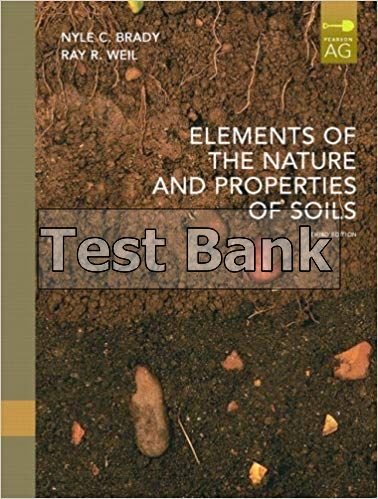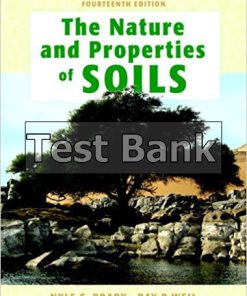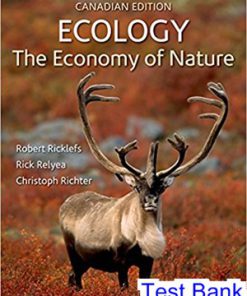Elements of the Nature and Properties of Soils 3rd Edition Brady Test Bank
$26.50$50.00 (-47%)
Elements of the Nature and Properties of Soils 3rd Edition Brady Test Bank.
You may also like
Elements of the Nature and Properties of Soils 3rd Edition Brady Test Bank

Product details:
- ISBN-10 : 0135014336
- ISBN-13 : 978-0135014332
- Author: Ray R. Weil, Nyle C. Brady
With an emphasis on the fundamentals, this book explores the important world of soils and the principles that can be used to minimize the degradation and destruction of one of our most important natural resources. Fully updated in this edition, it includes the latest information on soil colloids; nutrient cycles and soil fertility; and soils and chemical pollution. This edition is filled with hundreds of new figures and photos and continues to use examples from many fields, including agriculture, forestry, and natural resources. Taking an ecological approach, it emphasizes how the soil system is interconnected and the principles behind each soil concept. Updated information in this edition includes:
- Engineering properties of soils
- Expanded treatment of soil quality, soil degradation and soil resilience
- A new section on septic tank drain fields
- Expanded section on irrigation management
- A new section on wetlands and their poorly aerated soils
Table contents:
The Soils Around Us
1(26)
Soils as Media for Plant Growth
2(4)
Soil as Regulator of Water Supplies
6(1)
Soil as Recycler of Raw Materials
7(1)
Soil as Modifier of the Atmosphere
7(1)
Soil as Habitat for Soil Organisms
7(1)
Soil as Engineering Medium
8(1)
Pedosphere as Environmental Interface
9(1)
Soil as a Natural Body
9(2)
The Soil Profile and Its Layers (Horizons)
11(4)
Soil: The Interface of Air, Minerals, Water, and Life
15(1)
Mineral (Inorganic) Constituents of Soils
15(1)
Soil Organic Matter
16(3)
Soil Water: A Dynamic Solution
19(1)
Soil Air: A Changing Mixture of Gases
19(2)
Interaction of Four Components to Supply Plant Nutrients
21(1)
Nutrient Uptake by Plant Roots
22(1)
Soil Quality, Degradation, and Resilience
23(4)
Conclusion
25(1)
Study Questions
26(1)
References
26(1)
Formation of Soils from Parent Materials
27(31)
Weathering of Rocks and Minerals
28(4)
Factors Influencing Soil Formation
32(1)
Parent Materials
33(10)
Climate
43(1)
Biota: Living Organisms—Including Humans
44(3)
Topography
47(2)
Time
49(2)
Four Basic Processes of Soil Formation
51(1)
The Soil Profile
52(6)
Conclusion
56(1)
Study Questions
57(1)
References
57(1)
Soil Classification
58(38)
Concept of Individual Soils
59(1)
Comprehensive Classification System: Soil Taxonomy
60(4)
Categories and Nomenclature of Soil Taxonomy
64(1)
Soil Orders
65(4)
Entisols (Recent: Little if Any Profile Development)
69(1)
Inceptisols (Few Diagnostic Features: Inception of B Horizon)
70(1)
Andisols (Volcanic Ash Soils)
70(2)
Gelisols (Permafrost and Frost Churning)
72(1)
Histosols (Organic Soils Without Permafrost)
73(1)
Aridisols (Dry Soils)
74(2)
Vertisols (Dark, Swelling, and Cracking Clays)
76(2)
Mollisols (Dark, Soft Soils of Grasslands)
78(1)
Alfisols (Argillic or Natric Horizon, Moderately Leached)
78(2)
Ultisols (Argillic Horizon, Highly Leached)
80(1)
Spodosols (Acid, Sandy, Forest Soils, Highly Leached)
81(1)
Oxisols (Oxic Horizon, Highly Weathered)
82(1)
Lower-Level Categories in Soil Taxonomy
83(4)
Techniques for Mapping Soils
87(3)
Soils Surveys
90(6)
Conclusion
92(2)
Study Questions
94(1)
References
94(2)
Soil Architecture and Physical Properties
96(36)
Soil Color
97(1)
Soil Texture (Size Distribution of Soil Particles)
97(3)
Soil Textural Classes
100(4)
Structure of Mineral Soils
104(1)
Formation and Stabilization of Soil Aggregates
105(5)
Tillage and Structural Management of Soils
110(4)
Soil Density and Compaction
114(7)
Pore Space of Mineral Soils
121(2)
Soil Properties Relevant to Engineering Uses
123(9)
Conclusion
129(1)
Study Questions
130(1)
References
130(2)
Soil Water: Characteristics and Behavior
132(33)
Structure and Related Properties of Water
133(2)
Capillary Fundamentals and Soil Water
135(2)
Soil Water Energy Concepts
137(3)
Soil Water Content and Soil Water Potential
140(4)
The Flow of Liquid Water in Soil
144(6)
Infiltration and Percolation
150(4)
Water Vapor Movement in Soils
154(1)
Qualitative Description of Soil Wetness
154(3)
Factors Affecting the Amount of Plant-Available Soil Water
157(8)
Conclusion
162(1)
Study Questions
163(1)
References
164(1)
Soil and the Hydrologic Cycle
165(36)
The Global Hydrologic Cycle
166(2)
Fate of Precipitation and Irrigation Water
168(4)
The Soil-Plant-Atmosphere Continuum
172(4)
Control of Vapor Losses
176(4)
Liquid Losses of Water from the Soil
180(2)
Percolation and Groundwaters
182(3)
Enhancing Soil Drainage
185(4)
Septic Tank Drain Fields
189(4)
Irrigation Principles and Practices
193(8)
Conclusion
198(1)
Study Questions
199(1)
References
199(2)
Soil Aeration and Temperature
201(34)
Soil Aeration—The Process
202(2)
Means of Characterizing Soil Aeration
204(1)
Oxidation Reduction (Redox) Potential
205(2)
Factors Affecting Soil Aeration and Eh
207(1)
Ecological Effects of Soil Aeration
208(3)
Aeration in Relation to Soil and Plant Management
211(2)
Wetlands and Their Poorly Aerated Soils
213(5)
Processes Affected by Soil Temperature
218(6)
Absorption and Loss of Solar Energy
224(2)
Thermal Properties of Soils
226(3)
Soil Temperature Control
229(6)
Conclusion
232(1)
Study Questions
233(1)
References
233(2)
The Colloidal Fraction: Seat of Soil Chemical and Physical Activity
235(34)
General Properties and Types of Soil Colloids
236(4)
Fundamentals of Layer Silicate Clay Structure
240(2)
Mineralogical Organization of Silicate Clays
242(3)
Characteristics of Nonsilicate Colloids
245(2)
Genesis and Geographic Distribution of Soil Colloids
247(1)
Sources of Charges on Soil Colloids
248(2)
Adsorption of Cations and Anions
250(2)
Cation Exchange Reactions
252(2)
Cation Exchange Capacity
254(2)
Exchangeable Cations in Field Soils
256(3)
Anion Exchange
259(2)
Sorption of Organic Compounds
261(1)
Binding of Biomolecules to Clay and Humus
262(1)
Physical Implications of Swelling-Type Clays
263(6)
Conclusion
266(1)
Study Questions
267(1)
References
268(1)
Soil Acidity, Alkalinity, Aridity, and Salinity
269(53)
Processes That Cause Soil Acidity and Alkalinity
270(5)
Role of Aluminum in Soil Acidity
275(1)
Pools of Soil Acidity
276(3)
Buffering of pH in Soils
279(3)
Soil pH in the Field
282(1)
Human-Influenced Soil Acidification
283(4)
Biological Effects of Soil pH
287(4)
Raising Soil pH by Liming
291(5)
Alternative Ways to Ameliorate the Ill Effects of Soil Acidity
296(1)
Lowering Soil pH
297(1)
Characteristics and Problems of Dry-Region Soils
298(3)
Development of Salt-Affected Soils
301(2)
Measuring Salinity and Sodicity
303(3)
Classes of Salt-Affected Soils
306(2)
Physical Degradation of Soil by Sodic Chemical Conditions
308(1)
Growth of Plants on Salt-Affected Soils
309(3)
Water-Quality Considerations for Irrigation
312(2)
Reclamation of Saline Soils
314(2)
Reclamation of Saline-Sodic and Sodic Soils
316(6)
Conclusion
318(1)
Study Questions
319(1)
References
320(2)
Organisms and Ecology of the Soil
322(39)
The Diversity of Organisms in the Soil
323(2)
Organisms in Action
325(4)
Organism Abundance, Biomass, and Metabolic Activity
329(1)
Earthworms
330(4)
Ants and Termites
334(1)
Soil Microanimals
335(3)
Plants—Especially Roots
338(2)
Soil Fungi
340(5)
Soil Prokaryotes: Bacteria and Archaea
345(4)
Conditions Affecting the Growth of Soil Microorganisms
349(1)
Beneficial Effects of Soil Organisms on Plant Communities
350(1)
Soil Organisms and Damage to Higher Plants
351(4)
Ecological Relationships among Soil Organisms
355(6)
Conclusion
358(1)
Study Questions
358(1)
References
359(2)
Soil Organic Matter
361(35)
The Global Carbon Cycle
362(3)
The Process of Decomposition in Soils
365(3)
Factors Controlling Rates of Decomposition and Mineralization
368(4)
Genesis and Nature of Soil Organic Matter and Humus
372(2)
Influences of Organic Matter on Plant Growth and Soils
374(4)
Amounts and Quality of Soil Organic Matter
378(2)
Carbon Balance in the Soil-Plant-Atmosphere System
380(3)
Factors and Practices Influencing Soil Organic Levels
383(4)
The Greenhouse Effect: Soils and Climate Change
387(4)
Composts and Composting
391(5)
Conclusion
393(1)
Study Questions
394(1)
References
395(1)
Nutrient Cycles and Soil Fertility
396(59)
Nitrogen in the Soil System
397(15)
Sulfur and the Soil System
412(8)
Phosphorus and Soil Fertility
420(13)
Potassium in Soils and Plants
433(6)
Calcium as Essential Nutrient
439(2)
Magnesium as a Plant Nutrient
441(1)
Micronutrients in the Soil-Plant System
442(5)
Factors Influencing the Availability of Micronutrient Cations
447(3)
Factors Influencing the Availability of the Micronutrient Anions
450(5)
Conclusion
451(1)
Study Questions
452(1)
References
453(2)
Practical Nutrient Management
455(44)
Goals of Nutrient Management
456(1)
Environmental Quality
457(9)
Recycling Nutrients Through Animal Manures
466(4)
Industrial and Municipal By-Products
470(3)
Practical Utilization of Organic Nutrient Sources
473(3)
Inorganic Commercial Fertilizers
476(5)
Fertilizer Application Methods
481(2)
Timing of Fertilizer Application
483(1)
Diagnostic Tools and Methods
484(4)
Soil Analysis
488(4)
Site-Index Approach to Phosphorus Management
492(7)
Conclusion
495(1)
Study Questions
496(1)
References
496(3)
Soil Erosion and Its Control
499(36)
Significance of Soil Erosion and Land Degradation
500(2)
On-Site and Off-Site Effects of Accelerated Soil Erosion
502(2)
Mechanics of Water Erosion
504(3)
Models to Predict the Extent of Water-Induced Erosion
507(1)
Factors Affecting Interrill and Rill Erosion
508(5)
Conservation Tillage
513(3)
Vegetative Barriers
516(1)
Control of Gully Erosion and Mass Wasting
517(2)
Control of Accelerated Erosion on Range- and Forestland
519(2)
Erosion and Sediment Control on Construction Sites
521(3)
Wind Erosion: Importance and Factors Affecting It
524(3)
Predicting and Controlling Wind Erosion
527(1)
Progress in Soil Conversation
528(7)
Conclusion
531(1)
Study Questions
532(1)
References
533(2)
Soils and Chemical Pollution
535(31)
Toxic Organic Chemicals
536(2)
Kinds of Organic Contaminants
538(2)
Behavior of Organic Chemicals in Soil
540(5)
Remediation of Soils Contaminated with Organic Chemicals
545(6)
Contamination with Toxic Inorganic Substances
551(2)
Reactions of Inorganic Contaminants in Soils
553(4)
Prevention and Elimination of Inorganic Chemical Contamination
557(1)
Landfills
558(3)
Radon Gas from Soils
561(5)
Conclusion
563(1)
Study Questions
564(1)
References
564(2)
Appendix A World Reference Base, Canadian, and Australian Soil Classification Systems
566(5)
Appendix B Sl Units, Conversion Factors, Periodic Table of the Elements, and Plant Names
571(6)
Glossary of Soil Science Terms
577(19)
Index
596
People also search:
elements of the nature and properties of soils 3rd edition
elements of the nature and properties of soils
what are the three main physical properties of soil
what are the 3 physical properties of soil
elements of the nature and properties of soils pdf












